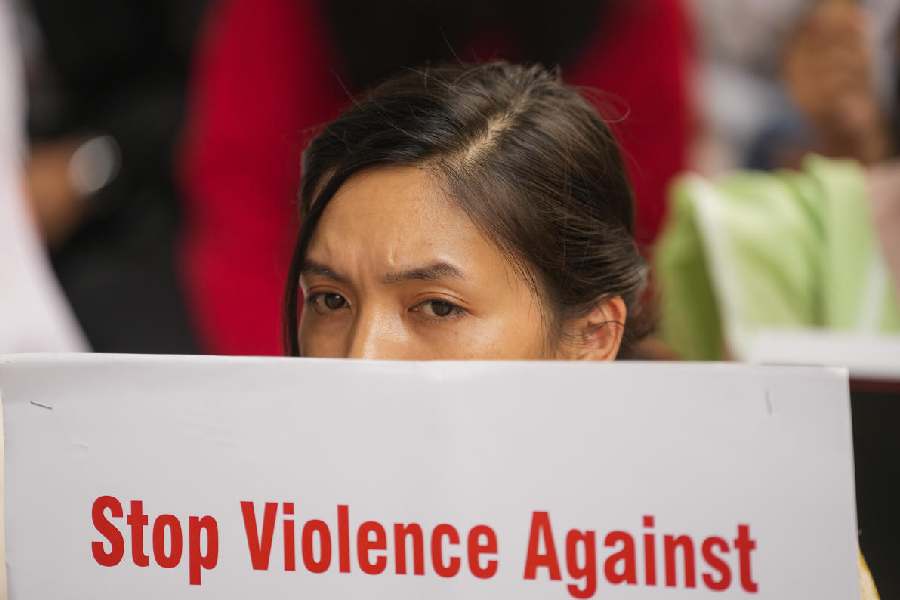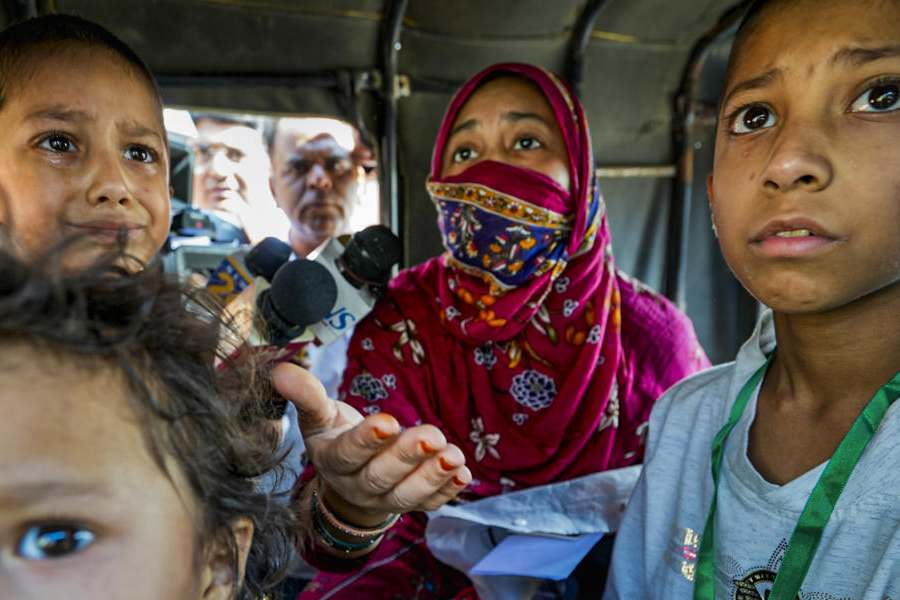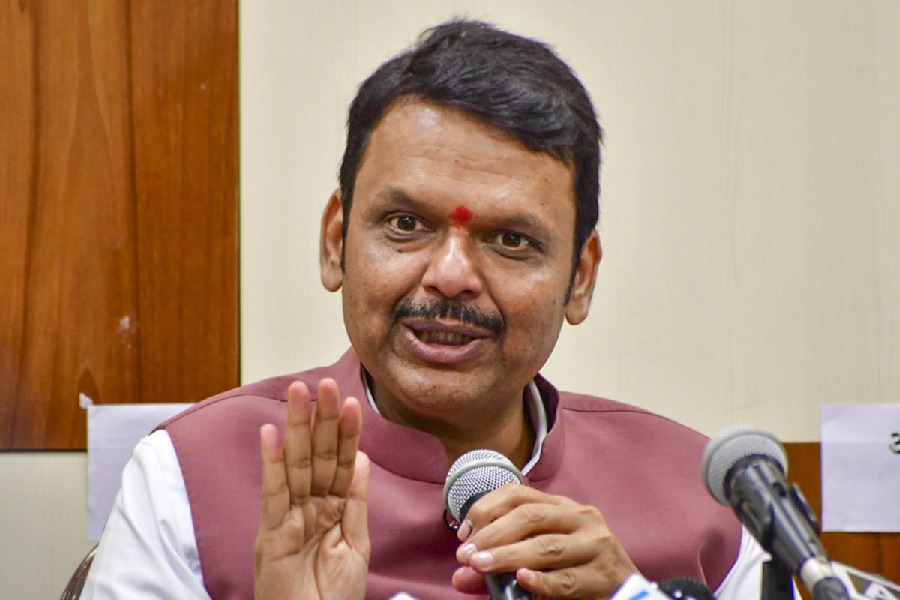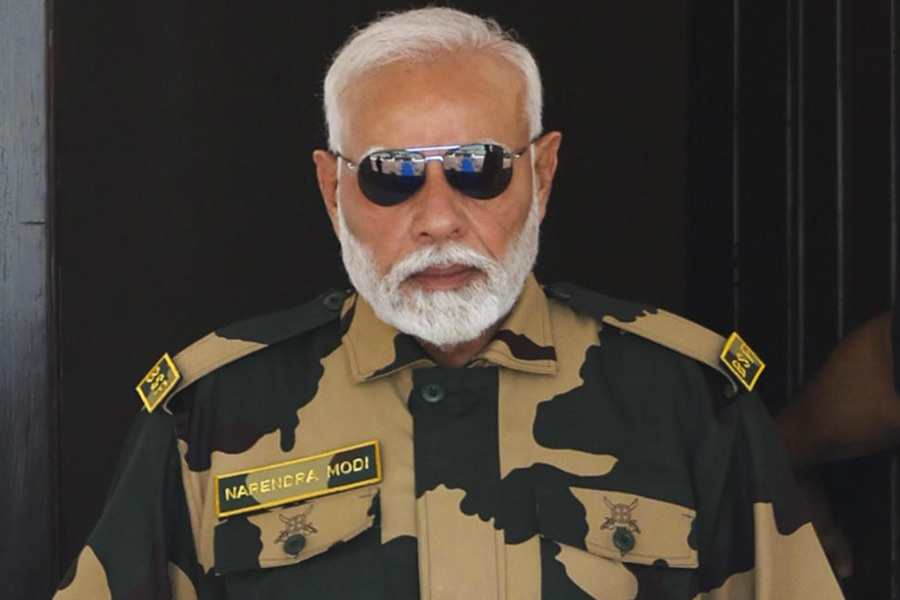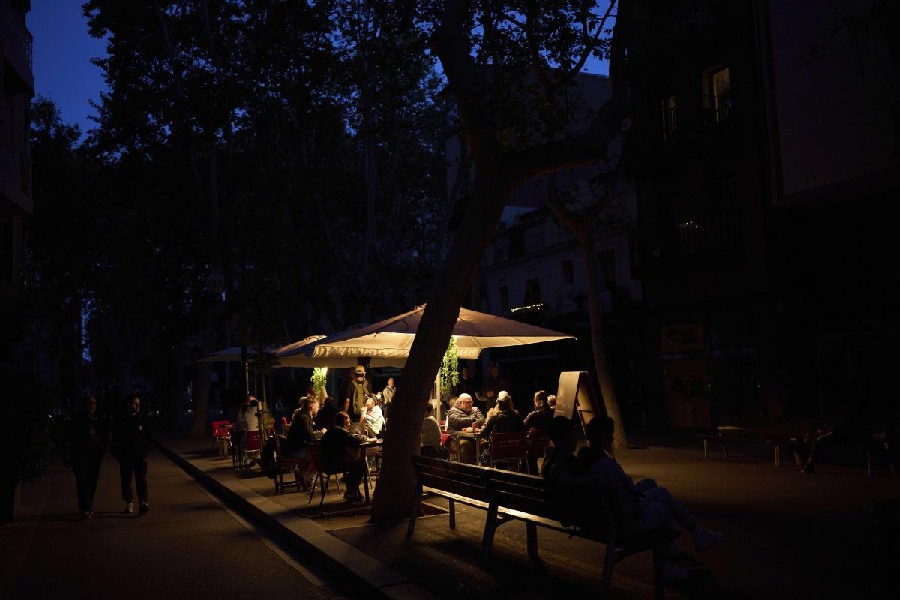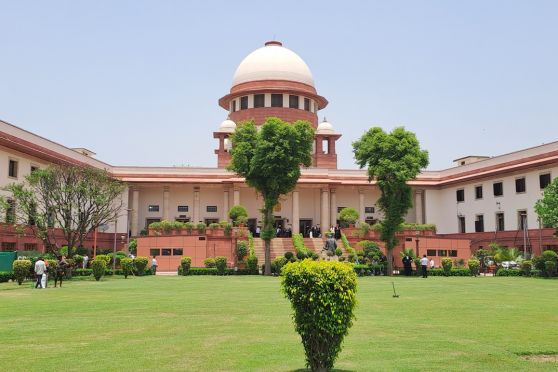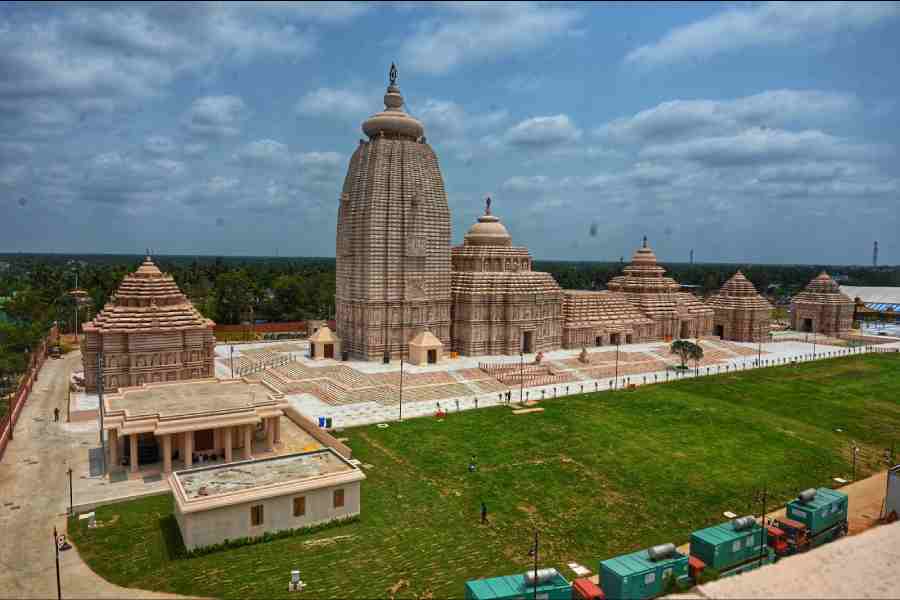 |
| Calcutta shines bright at the Lakmé Fashion Week — Jesse Randhawa flanked by Nil and Dev (above); a model shows off a sari by Abhishek Dutta (below) |
 |
Fashion trends come and go. But this fashion trend looks steady enough to stay. Yup, there’s no skirting the issue — Calcutta is scaling new heights on the fashion curve. And whoever says that the city is still in the dark ages as far as style is concerned, needs to zip it and read between the fine stitching.
Without doubt, the raw talent has always been there. But now, more local designers — who were hitherto content with hawking their designs from their boutiques — are looking beyond the fringes of the city. Why, they’re even eyeing a slice of the global fashion pie. And what’s more, the applause is raining down from all quarters. Local lads Dev R Nil and Abhishek Dutta, husband-wife duo Swapan and Seema and others like Sucheta Merh are all winning major points for their work - both in the country and outside.
Industry insiders say it was Sabyasachi Mukherjee who brought about a giant change in the city’s fashion barometer with his unique design sensibility. Known for blending Indian textiles with Western sensibilities, Pepsi (as he’s known to friends) takes great pride in his Bengali connection. “It’s difficult to put down a city like Calcutta because Bengalis have a unique way of looking at things. I strongly feel that Calcutta thinks differently from the rest of India be it in sports or in fashion,” he says.
“Perhaps I helped to open people’s eyes, but the talent has always been here. Today, glitter and glam is slowly giving way to refinement, and that’s where Calcutta designers score,” says Sabyasachi who also retails from international stores like Saks Fifth Avenue and Browns.
As expected Sabyasachi scored big at the recently-concluded Lakmé Fashion Week (LFW) in Mumbai. Fresh from his turn at New York’s Olympus Fashion Week, Sabyasachi’s creations took centre-stage at the Grand Finale, and he didn’t disappoint. His Lakmé, Free Sprit by Day and Night collection closed to deafening cheers. Explaining his creations, he says, “The first line was based on the philosophy of ‘less is more’, the second had sportswear that can be turned into eveningwear, the third was inspired by painter Frida Kahlo and the fourth line was inspired by Gothic art.”
The embellishments were tonal with embroidery, quilting and piping playing vital roles. Layering, his forte, was executed with great panache as seen in the short blousons, minis and even the majestic, long gowns. All the Sabyasachi classics were also in place — the wonderfully crafted smocks, trapeze dresses, swing coats and elegant saris with dramatic cholis. The showstoppers for the evening were Raima Sen draped in a beautiful black sari, Indrani Dasgupta in a striking green trenchcoat and Katrina Kaif in a regal gown.
If Browns already has one Calcutta designer retailing from its racks, it may very well soon add a couple more to its list. Its international buyer Albert Morris, who attended LFW, came away very impressed by debutant design duo Dev R Nil. Dev (aka Devarghya Bairagi) R Nil (aka Navonil Das) wowed Mumbai’s social set with their collection titled Chocolate, which had pre-stitched saris with embroidered waistbands, skirts, corsets, wrap tunics and bubble dresses. Playful twists like pleats in georgette and dramatically-executed smocking for the bodices and hems added that extra edge.
Dev R Nil’s LFW showing also came with the celebrity stamp by way of actress Tabu who will be wearing their creations for the promotional tours of Meera Nair’s The Namesake. Tabu waxed eloquent about the duo: “I liked their collection because of its sheer simplicity and exquisite detailing.”
Heady from their success, Dev, an NIFD graduate and Nil, a product of the Canberra Institute of Technology, Australia, however want to tread carefully and take small steps. “Although we’ve received a positive response, we don’t want to hurry. Participating in the Fashion Week has just initiated the process. We want to strengthen our label globally,” says Nil.
Also earning rave reviews at LFW was city boy Abhishek Dutta who presented a collection called Immortality in a muted palette of beige, green and peach. The clothes ranged from saris to Westernwear in fabrics like knits, cottons, silks, brocades and chiffons. The eye-catchers in this line were the multi-fabric pleated short mermaid skirt, the balloon skirt worn with a corset blouse, a pair of capris and a pair of tight, rouched churidars worn with a bodice and ballerina skirt. Dutta didn’t really have a chance to soak in the applause though, as he hurried east to participate in the Singapore Fashion Week.
His walk up the fashion path was not easy, but today Abhishek retails from some of the country’s top ateliers including Aza, Samsara, Origins and Kimaya as well as from stores in Singapore, Riyadh, Kuwait, Malaysia, London, New York and Los Angeles.
So is there a Calcutta school of fashion emerging? There could very well be. Says Abhishek, “Although Calcutta still lacks a certain seriousness that the fashion industry demands, yet designers here have a distinctive style of their own. And compared to the rest of India where the colour palette is very loud, we generally like to work with muted colours.”
The Indian fashion industry is coming of age agrees Morris. But he feels that Indian designers still need a bit of spit and polish in every aspect — right from meeting deadlines and conducting fittings to making clothes according to body types. “The right package and consistency in design are key in making a global impact,” he adds.
The question is, do Calcutta designers have what it takes? Veteran style guru, Kiran Uttam Ghosh seems to think so. “The city is an art hub, and fashion and art have co-existed happily here. With the rest of the world getting more jaded and with less time to invest in creating good art and good fashion, Calcutta has a fresh artistic perspective,” she says.
Agrees model Deepti Gujral who shifted base from the city to Mumbai a few years ago, “Bengal always had a slight edge in terms of its design elements due to the richness of its culture.”
A fine example is designer Sucheta Merh who continually relies on the very Bengali kantha work, tangail borders and signature fish motifs to embellish her creations. But while Merh may focus on the local, she doesn’t believe in ignoring the bigger picture — which is why she participated in LIFW last year and the Wills Lifestyle India Fashion Week 2006. Her line for WLFW was inspired by the famous Tree of Hope painting by Frida Kahlo. Chic and trendy, it took in stylised gheredar dresses teamed with churidars and leggings, jackets, tunics and balloon tops in subdued colours.
“While there is a dedicated lot of creative people who want to work and stay in the city, come what may, there’s a lack of serious buyers in Calcutta compared to Mumbai and Delhi. Those cities are part of a more serious fashion movement,” says Sucheta.
City-based designer-couple, Swapan and Seema Suhasaria, who’ve just returned from a successful stint at the Singapore Fashion Week have their own grouses. “The fashion atmosphere in Calcutta is not really conducive to hosting large fashion shows — at least not at present,” says Swapan.
After their Singapore experience, both Swapan and Seema feel that India has a lot of catching up to do, in terms of infrastructure. “I wish I could uproot the entire convention centre at Singapore and bring it to Mumbai or Delhi,” laughs Swapan. He adds, “Here in Calcutta, the problems are myriad ranging from a lack of space to cramped quarters backstage and an absence of models and choreographers.”
Yet with all the bottlenecks they face, the couple is optimistic about the future. “The expansion in capital investment and the IT boom in West Bengal will help Calcutta develop as a strong market,” says Swapan.
Also helping is the fact that the couple has a presence in most of India’s elite stores (they’ve just opened their brand new store, Swapan and Seema in Delhi) and even a couple in LA and the UK. Of course at the heart of everything lies their innate talent, evident from their Madame Butterfly collection, showcased at WLFW earlier this year and the Singapore Fashion Week.
Deviating from their usual vibrant palette to embrace pastel shades in blue, pink and cream, the collection reflected a strong Japanese influence evident in the kimono dresses, wrap tops, flowing skirts and tunics, and of course bridalwear.
Besides the obvious pool of talent, just what is causing Calcutta designers to steal the limelight? Reasons fashion designer Agnimitra Paul, “Firstly, several established local designers like Sharbari Datta, Anamika Khanna and Kiran Uttam Ghosh have shown the way to the current crop of designers, making it easier for us. Secondly,
Bengal seems to be the flavour of the moment be it in novels, movies or food.”
Agnimitra herself is going full steam ahead with her plans to feature in one of the fashion weeks next year. Where will inspiration come from? “I always look to various cultures for creative stimulation,” she says — obvious from her present collection, Diary from Bhutan, which is dominated by Bhutanese brocades and Buddhist motifs.
Though the city is taking small steps to get recognised in the global fashion scene, there are a few shortfalls that need to be fixed. As Kiran Uttam Ghosh points out, “We have a lot working for us and the city has the creative credibility to sustain an event like a fashion week. But I worry about the lack of infrastructure. For instance, our airport has poor connectivity with the rest of the world. How do international buyers connect with us? Then there is also the problem of bandhs crippling the city. Can you imagine the wastage of time and money if fashion week is shut down for a day? What will that do for our image? These are our handicaps and they need to be addressed seriously.” Mr Chief Minister, are you listening?
Calcutta connection
 |
 |
![]() Nikasha Tawdey: Born and brought up in Calcutta, this Mumbai-based designer was all set to become a psychoanalyst. But she took up fashion designing instead and launched her prêt label, Nikasha. Her collection for LFW was influenced by the international fashion trends echoed in Calcutta back in the ‘60s and ‘70s. Titled the Great Eastern Collection, her inspiration came from The Great Eastern Hotel.
Nikasha Tawdey: Born and brought up in Calcutta, this Mumbai-based designer was all set to become a psychoanalyst. But she took up fashion designing instead and launched her prêt label, Nikasha. Her collection for LFW was influenced by the international fashion trends echoed in Calcutta back in the ‘60s and ‘70s. Titled the Great Eastern Collection, her inspiration came from The Great Eastern Hotel.
![]() Deepti Toor: She was discovered in the Indian fashion fraternity as a Gen Next Designer at LFW early this year. Her current collection for LFW has been inspired from Mughal miniature paintings. The details, surface ornamentation and colours in her creations capture the mood of the paintings. Though she is from Ahmedabad, Deepti has been the creative mind behind R & B Enterprises, a Calcutta-based fashion export house, which was set up in 1996 by brothers Swarup and Arup Ghosh. The fabrics used in her line are mostly matka silks, cottons and cotton blends, and Bengal handlooms.
Deepti Toor: She was discovered in the Indian fashion fraternity as a Gen Next Designer at LFW early this year. Her current collection for LFW has been inspired from Mughal miniature paintings. The details, surface ornamentation and colours in her creations capture the mood of the paintings. Though she is from Ahmedabad, Deepti has been the creative mind behind R & B Enterprises, a Calcutta-based fashion export house, which was set up in 1996 by brothers Swarup and Arup Ghosh. The fabrics used in her line are mostly matka silks, cottons and cotton blends, and Bengal handlooms.
![]() Anupama Dayal: A graduate from IIM, Calcutta, she took up designing after years of watching her mother (a textile designer) working with rich fabrics. Blending Indian crafts with Western silhouettes comes easy to Anupama and her collection called Grace had a beauty and femininity that gave the line a stylish edge. Her inspirations for her Spring-Summer 2007 collection were a mixed bag right from Japanese Samurais, an old Afghan rug and even the dry leaves in her garments.
Anupama Dayal: A graduate from IIM, Calcutta, she took up designing after years of watching her mother (a textile designer) working with rich fabrics. Blending Indian crafts with Western silhouettes comes easy to Anupama and her collection called Grace had a beauty and femininity that gave the line a stylish edge. Her inspirations for her Spring-Summer 2007 collection were a mixed bag right from Japanese Samurais, an old Afghan rug and even the dry leaves in her garments.
Additional reporting by Janine Martin and Anindita Mitra
LFW photographs by Gajanan Dudhalkar


